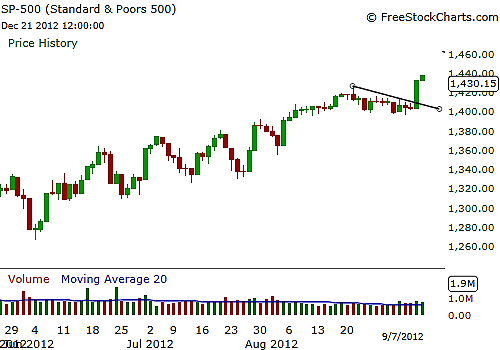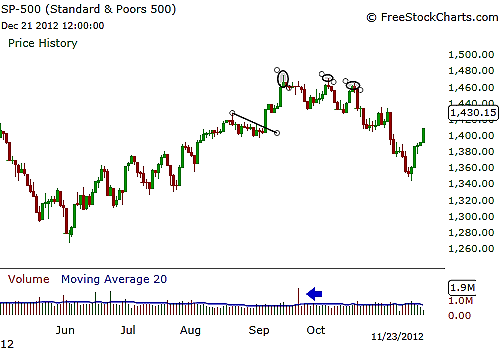
HOT TOPICS LIST
- MACD
- Fibonacci
- RSI
- Gann
- ADXR
- Stochastics
- Volume
- Triangles
- Futures
- Cycles
- Volatility
- ZIGZAG
- MESA
- Retracement
- Aroon
INDICATORS LIST
LIST OF TOPICS
PRINT THIS ARTICLE
by Billy Williams
Beginning traders and advanced beginning traders focus on the basics of trading to profit, while everyone else tends to chase the latest gimmick.
Position: Hold
Billy Williams
Billy Williams has been trading the markets for 27 years, specializing in momentum trading with stocks and options.
PRINT THIS ARTICLE
TECHNICAL ANALYSIS
Advanced Beginners And The Markets
01/03/13 09:48:12 AMby Billy Williams
Beginning traders and advanced beginning traders focus on the basics of trading to profit, while everyone else tends to chase the latest gimmick.
Position: Hold
| Back when the Green Bay Packers were led by legendary coach Vince Lombardi, when the team suffered an uncharacteristic loss after a game, Lombardi would call them to the practice field and tell them he was to blame for the loss, not them. He would go on to say that it was evident to him that they needed a refresher on the basics and would then hold up a football and say, "Men, this is a football." Champions return to the basics over and over again because they are the building blocks to success in any field, and the rote repetition of lessons and practice drills are the cornerstone to mastery. In trading, it is the same. In trading, bull and bear markets are created by buyers and sellers that are negotiating prices, nothing more and nothing less. |
| Through supply and demand, markets will go up, down, or sideways. This is important to remember because most people think of the markets as up and down without considering a third way, and failing to adapt to the market at hand. Trends are also spotted on three different time frames -- short term, intermediate term, and long term. Depending on the trend, price will contract or expand, again depending on supply and demand by the buyers and sellers. If price is contracting, then it will move between two price points until one side -- bulls or bears -- gain control of price and force price into expansion. See Figure 1. |

|
| FIGURE 1: SPX. On the SPX, price had been rising steadily, then traded sharply upward from an impulse move that occurred before pulling back. Price pulled back smoothly since it had a lot of momentum still behind the upward thrust, and price continued its upward series of higher highs and higher lows in its price action. |
| Graphic provided by: www.freestockcharts.com. |
| |
| Likewise, if the market is expanding, then either the bulls or bears have gained control of price and price will move in a steady series of higher highs and higher lows if in a uptrend or a series of lower highs and lower lows if in a downtrend. The ebb and flow of price action is common, but what is not commonly understood are the pullbacks in price. At times, pullbacks can be messy and confusing, not at all like they appear to be in the simplified technical analysis manuals that every trader has studied. This is where the "advanced beginner" begins to make fine distinctions between different pullbacks and adapts to them. |

|
| FIGURE 2: SPX. Later, price peaked before pulling back, but note that price failed to make a higher high and then made three steady series of lower lows and lower highs until the bullish trend integrity was violated and control passed to the bears. |
| Graphic provided by: www.freestockcharts.com. |
| |
| Simple pullbacks form when price is moving from a contracted price range and into a period of expansion. That initial move out of contraction is referred to as the "impulse" move, or momentum move. This is the birthplace of all price trends and any pullbacks that follow are likely to be smooth, and temporary reversals as traders who take an early position take their first profits and Johnny-come-lately traders hop on and take a position, and fuel a resumption of the new trend. See Figure 2. It's later on that pullbacks become more difficult to trade because they zigzag as the result of not having the strength of the impulse move behind its breakout. Instead of resuming the trend, price oscillates, leaving the integrity of the trend in question. This trading back and forth without setting new highs and lows, depending on the direction of the move, cause these kind of pullbacks to be labeled as "complex" pullback, or complex consolidations. |
| When price becomes more complex, then it is likely to reverse and you have to watch it closely to see if it will either continue setting higher highs and higher lows if it's an upward move or lower highs and lower lows if it's in a bullish trend. If price fails to resume that pattern, then price is likely to reverse or go sideways and for you, as a trader, you must adapt to the changing dynamics by exiting, taking profits, or tightening up your stops, or all of the above to some degree. These are the basics of trading and are the foundation of everything that you do to the market. Beginnings are for beginners and advanced beginners, with everything in the middle left to scramble and buy the latest indicator, esoteric trading approach, and/or trading system launched. However, if you keep the trading basics close to you and practice them daily, the good news is that you won't have to return to them over and over again if you stray too far chasing gimmicks. |
Billy Williams has been trading the markets for 27 years, specializing in momentum trading with stocks and options.
| Company: | StockOptionSystem.com |
| E-mail address: | stockoptionsystem.com@gmail.com |
Traders' Resource Links | |
| StockOptionSystem.com has not added any product or service information to TRADERS' RESOURCE. | |
Click here for more information about our publications!
PRINT THIS ARTICLE

|

Request Information From Our Sponsors
- StockCharts.com, Inc.
- Candle Patterns
- Candlestick Charting Explained
- Intermarket Technical Analysis
- John Murphy on Chart Analysis
- John Murphy's Chart Pattern Recognition
- John Murphy's Market Message
- MurphyExplainsMarketAnalysis-Intermarket Analysis
- MurphyExplainsMarketAnalysis-Visual Analysis
- StockCharts.com
- Technical Analysis of the Financial Markets
- The Visual Investor
- VectorVest, Inc.
- Executive Premier Workshop
- One-Day Options Course
- OptionsPro
- Retirement Income Workshop
- Sure-Fire Trading Systems (VectorVest, Inc.)
- Trading as a Business Workshop
- VectorVest 7 EOD
- VectorVest 7 RealTime/IntraDay
- VectorVest AutoTester
- VectorVest Educational Services
- VectorVest OnLine
- VectorVest Options Analyzer
- VectorVest ProGraphics v6.0
- VectorVest ProTrader 7
- VectorVest RealTime Derby Tool
- VectorVest Simulator
- VectorVest Variator
- VectorVest Watchdog
